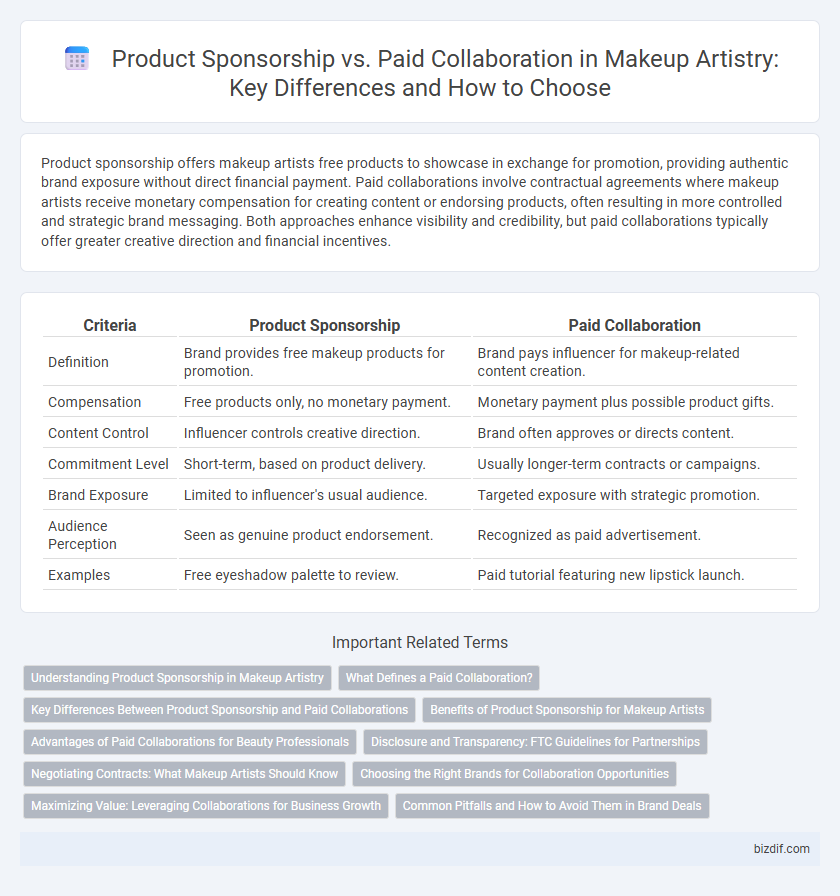Product sponsorship offers makeup artists free products to showcase in exchange for promotion, providing authentic brand exposure without direct financial payment. Paid collaborations involve contractual agreements where makeup artists receive monetary compensation for creating content or endorsing products, often resulting in more controlled and strategic brand messaging. Both approaches enhance visibility and credibility, but paid collaborations typically offer greater creative direction and financial incentives.
Table of Comparison
| Criteria | Product Sponsorship | Paid Collaboration |
|---|---|---|
| Definition | Brand provides free makeup products for promotion. | Brand pays influencer for makeup-related content creation. |
| Compensation | Free products only, no monetary payment. | Monetary payment plus possible product gifts. |
| Content Control | Influencer controls creative direction. | Brand often approves or directs content. |
| Commitment Level | Short-term, based on product delivery. | Usually longer-term contracts or campaigns. |
| Brand Exposure | Limited to influencer's usual audience. | Targeted exposure with strategic promotion. |
| Audience Perception | Seen as genuine product endorsement. | Recognized as paid advertisement. |
| Examples | Free eyeshadow palette to review. | Paid tutorial featuring new lipstick launch. |
Understanding Product Sponsorship in Makeup Artistry
Product sponsorship in makeup artistry involves brands providing free cosmetics or tools to artists in exchange for promoting products to their audience, enhancing brand visibility through authentic usage and reviews. Unlike paid collaborations, sponsorships emphasize ongoing brand support without direct monetary exchange, relying on the artist's influence to drive consumer interest. This form of partnership boosts credibility and helps makeup artists build relationships with industry-leading brands while showcasing professional expertise.
What Defines a Paid Collaboration?
A paid collaboration in makeup artistry is defined by a formal agreement where the artist receives compensation for creating and promoting content featuring a brand's products. Unlike product sponsorships where only free products are provided, paid collaborations involve financial remuneration in exchange for marketing efforts and guaranteed deliverables. These partnerships often include contract terms outlining usage rights, deadlines, and exclusivity to ensure mutual benefits and clear expectations.
Key Differences Between Product Sponsorship and Paid Collaborations
Product sponsorship in makeup artistry typically involves brands providing free products to artists in exchange for organic promotion, emphasizing mutual benefit without direct monetary compensation. Paid collaborations, however, include formal agreements where artists receive financial payment alongside products for creating specific content tailored to the brand's marketing strategy. The key differences lie in compensation structure, contractual obligations, and the level of creative control maintained by the makeup artist during the promotion.
Benefits of Product Sponsorship for Makeup Artists
Product sponsorship offers makeup artists valuable opportunities to receive high-quality cosmetics without the immediate financial burden, enabling them to experiment with diverse brands and styles. This type of partnership enhances portfolio variety and increases social media engagement by showcasing sponsored products in creative tutorials and looks. Moreover, product sponsorships often lead to long-term relationships with beauty brands, providing ongoing access to new launches and exclusive professional tools.
Advantages of Paid Collaborations for Beauty Professionals
Paid collaborations provide beauty professionals with financial compensation that reflects their expertise and effort, ensuring sustainable income beyond product giveaways. These partnerships often allow for creative control and tailored branding opportunities, enhancing the artist's portfolio and market presence. Furthermore, paid collaborations foster long-term relationships with reputable brands, boosting credibility and opening doors to exclusive industry projects.
Disclosure and Transparency: FTC Guidelines for Partnerships
Product sponsorships require clear disclosure that the makeup artist received the products for free, ensuring transparency with followers as mandated by FTC guidelines. Paid collaborations must explicitly state the financial exchange involved in the partnership, promoting honest communication about the influencer's endorsement. Both types of partnerships demand compliance with FTC rules to maintain trust and avoid legal repercussions.
Negotiating Contracts: What Makeup Artists Should Know
When negotiating contracts, makeup artists must clearly define the scope of product sponsorships, specifying usage rights, exclusivity, and deliverables to avoid ambiguity. Paid collaborations require transparent agreements on compensation, timelines, and content ownership to protect both parties' interests and ensure fair remuneration. Understanding key contract elements such as exclusivity clauses, termination conditions, and intellectual property rights is crucial for makeup artists to secure professional and profitable partnerships.
Choosing the Right Brands for Collaboration Opportunities
Selecting the right brands for makeup artistry collaborations hinges on aligning product sponsorships with your personal brand and audience preferences to maximize authenticity and engagement. Product sponsorships offer complimentary items for promotion, while paid collaborations involve financial compensation, each requiring careful evaluation of brand reputation, product quality, and target demographics. Prioritize partnerships that enhance your creative portfolio and resonate genuinely with your followers to build long-term credibility and professional growth.
Maximizing Value: Leveraging Collaborations for Business Growth
Product sponsorship offers makeup artists free products in exchange for promotion, enhancing brand visibility without immediate financial gain. Paid collaborations provide direct monetary compensation, enabling artists to invest in higher-quality tools and expand their creative services. Strategic use of both methods maximizes value by balancing cost-effective resources and cash flow, driving sustainable business growth in the competitive beauty industry.
Common Pitfalls and How to Avoid Them in Brand Deals
Product sponsorships often involve free or discounted makeup products in exchange for promotion, but common pitfalls include unclear usage rights and unrealistic expectations that can harm artist-brand relationships. Paid collaborations provide direct monetary compensation but may come with strict content guidelines and tight deadlines, limiting creative freedom. To avoid these issues, makeup artists should negotiate clear contracts outlining deliverables, usage rights, and deadlines to protect their work and maintain professional integrity in brand deals.
Product sponsorship vs Paid collaboration Infographic

 bizdif.com
bizdif.com